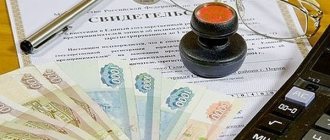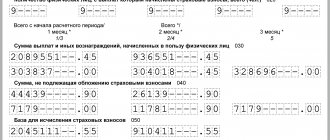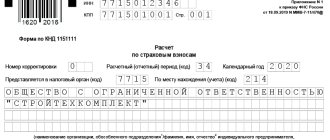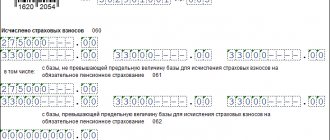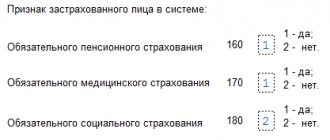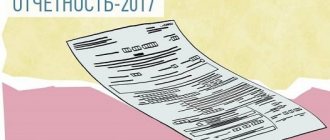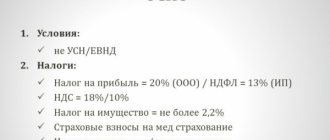Each company monthly transfers a certain percentage of the organization's payroll to the Social Insurance Fund. This money is accumulated in the Fund’s accounts and goes towards compensation payments in case of accidents at work or when occupational diseases are detected. The amount of funds transferred to the Social Insurance Fund depends on the presence (number) of harmful and dangerous factors in the organization (VF and PF, respectively), i.e. depending on the “danger” of the work, the Social Insurance Fund may receive funds from 0.2% to 8.5% (the maximum possible % of deductions) of deductions from the wage fund. Below is a small visual diagram of this mechanism.
If in production the number of insured events is large, and this amount is spent almost completely during the year, then for “office” companies it almost completely remains in the Social Insurance Fund of the Russian Federation. According to the Order of the Ministry of Labor of Russia dated December 10, 2012 No. 580n (hereinafter referred to as Order No. 580n) “Rules for financial support of preventive measures to reduce occupational injuries and occupational diseases of workers and sanatorium and resort treatment of workers engaged in work with harmful and (or) hazardous production factors ", the employer has the right to return up to 20% of the amount remaining in the Fund, using it to finance preventive measures to reduce occupational injuries and occupational diseases of workers and sanatorium-resort treatment of workers engaged in work with harmful and (or) dangerous production factors. For large companies, the amount of compensation from the Federal Social Insurance Fund of the Russian Federation can amount to millions. But in order to save this much, it is important to fill out all the necessary documents on time and correctly and know what you can spend these funds on.
New procedure for the return of insurance premiums for compulsory health insurance
On December 31, 2021, the Constitutional Court recognized the restriction of the employer’s right to receive from the budget overpaid funds for compulsory pension insurance (OPS) as inconsistent with the Constitution of the Russian Federation.
The reason for the refusal is that information about the amounts paid is posted on the individual personal accounts of the insured persons. The government was obliged to correct the situation and ensure that overpayments of insurance premiums are offset in 2021, including for compulsory insurance. The State Duma adopted amendments to the Tax Code of the Russian Federation aimed at establishing a new procedure for the reimbursement of insurance premiums for compulsory health insurance. Tax authorities will take into account the structure of the insurance payment tariff (its joint and several parts) and the fact whether a particular insured person has an insured event. If the employee has retired and a change in the information on the personal account will lead to a decrease in pension benefits, the amount of overpaid (collected) payments to the compulsory pension insurance will not be returned to the employer. In all other cases, the policyholder will receive compensation based on an application for the return of this amount. The new rules will begin to work on January 1, 2021, after the law is signed by the president. Until then, the Federal Tax Service authorities consider all applications for compensation individually, based on the position of the Constitutional Court of the Russian Federation.
Updated instructions from ConsultantPlus
To guarantee a refund and not be refused, use a ready-made solution (here is free access):
Go to instructions
Difficulties and pitfalls of reimbursement of funds from the Social Insurance Fund
The task of tax and other regulatory authorities is to replenish the state treasury, and not to distribute funds from it.
Therefore, even if a businessman has the right to compensation by law, it can be quite difficult to implement it in practice.
Fewer obstacles arise when it comes to standings, because There is no need to “directly” spend budget funds here.
And if the money needs to be returned, the employer should prepare to undergo a real “quest”.
Traditionally, the most difficult problem is the reimbursement of “social” expenses.
The simplest way for officials to “delay” the process is to order an inspection. A desk audit can last up to three months, an on-site audit – up to two, and in the presence of “special” circumstances (Clause 10, Article 26.16 of Law No. 125-FZ) – up to six months.
Also, inspectors often find fault with the preparation of documents, primarily sick leave certificates.
There is no dispute that false certificates of incapacity for work do occur, but officials sometimes refuse to reimburse funds due to purely “technical” errors. For example, a doctor made a “misprint” in the name of a sick employee.
But the courts usually side with employers in such cases. The judges point out that if errors in filling out sick leave are removable and do not affect the very fact of the validity of “social” payments, then the Social Insurance Fund is obliged to reimburse the employer’s expenses (resolution of the AS SKO dated May 27, 2016 in case No. A32-38535/2015 and AS ZSO dated 04/14/2017 in case No. A46-11541/2016).
Therefore, it is important for the employer to remember that if a regional division of the Federal Social Insurance Fund of the Russian Federation refuses compensation for any reason, he has the right to appeal this decision to a higher body of the fund or in court.
Who makes the return decision?
The body making the decision on the return of overpaid insurance contributions, penalties and fines depends on the reporting period for which the policyholder filed an application for overpayment. When applying for reporting (calculation) periods that expired before 01/01/2020, the decision is made by the authorities of the Pension Fund - for payments to compulsory pension insurance and the Social Insurance Fund of the Russian Federation - for payments for temporary disability and injuries.
This happens in agreement with the Federal Tax Service. To do this, within 10 working days from the date of receipt of a written application for
refund of the overpayment, the authorized bodies make a decision and no later than the next working day send a notification to the territorial tax authority at the place of registration of the policyholder for the actual transfer of overpaid amounts of insurance contributions, penalties and fines (letter of the Ministry of Finance dated 06/09/2017 No. 03-15-05/36284). There are still 30 days for this.
The decision to return overpaid deductions, penalties and fines for reporting (calculation) periods formed after 01/01/2017 is made by the tax authority (Article 78 of the Tax Code of the Russian Federation). The algorithm is fully consistent with the return of overpaid taxes.
Features of reporting
If there is a failure, you need to make changes to the reporting:
- 2-NDFL. The benefit amount needs to be removed. The accountant is required to draw up and submit a certificate of adjustments. This is relevant if the payments were initially subject to personal income tax and the employee returned the funds. If the employee has not returned the funds, you need to draw up a corrective 2-NDFL. The previously used code 2300 is replaced by code 4800. If the payments were not subject to personal income tax and the employee returned them, nothing needs to be changed in the reporting. If the funds were not taxed and the employee did not return them, he will generate income. It is recorded in reporting under code 4800.
- 6-NDFL. If the payment was subject to personal income tax and the employee returned it, you need to submit corrective reporting. It must be compiled and submitted also for previous periods. If payments were taxed, but the employee did not return them, nothing changes in the reporting. If the amount is not subject to personal income tax and the employee does not return it, he will generate income. Corrective reporting must be submitted.
Changes depend on whether the benefits are taxable and whether the amount is returned by the employee.
How to apply for an overpayment to the Social Insurance Fund
The FSS approved the application forms by order dated February 17, 2015 No. 49 (as amended on November 17, 2016)) in accordance with the norms of Part 1 of Article 21 of the Federal Law dated July 3, 2016 No. 250-FZ. It is impossible to issue a letter for refund of overpayment of insurance premiums in free form.
To return contributions for VNIM and injuries, you should contact the Social Insurance Fund with a prepared application for the return of overpayments on contributions in Form 23.
Set of documents 2021
In order for the FSS to allocate funds for the payment of insurance coverage (benefits), it is necessary to submit the required documents to the territorial body of the FSS at the end of the quarter or any month of 2021 (Order of the Ministry of Health and Social Development dated December 4, 2009 No. 951n):
- a written application in the form recommended in the letter of the Federal Social Insurance Fund of Russia dated December 7, 2021 No. 02-09-11/04-03-27029, with two attachments: – certificate of calculation (Appendix 1); – breakdown of expenses;
- copies of documents confirming the validity of expenses (for example, sick leave);
- other documents upon request of the FSS branch.
You can reference the calculations in Excel format.
Refund of overcharged amounts
If the tax authorities excessively collect amounts for periods expired before 01/01/2017, the question arises of how to return the overpayment of insurance premiums from the tax office in 2021 in such a situation? The decision to return excessively collected payments to OPS and VNiM for these periods is made directly by the Pension Fund of Russia and the Social Insurance Fund. The norms of the Tax Code do not apply (letters of the Federal Tax Service of the Russian Federation dated July 27, 2017 No. ED-4-8/14778, dated June 20, 2017 No. GD-4-8/ [email protected] , letter of the Ministry of Finance dated July 19, 2017 No. 03-02-07 /2/ [email protected] ).
Things are different if the policyholder wants to know how to return the overpayment under the Social Insurance Fund in 2021 that arose after 01/01/2017. The procedure is determined by tax legislation. During this period, the decision is made by the tax authorities in accordance with the provisions of Article 79 of the Tax Code of the Russian Federation. It is enough to contact the Federal Tax Service Inspectorate in writing with a statement in the established form.
IMPORTANT!
There is no general algorithm for how to return insurance premiums from the Pension Fund in 2020. The Federal Tax Service will develop it after the amendments to the Tax Code of the Russian Federation enter into force.
The employee received a writ of execution: accounting
If an employee has received a writ of execution, that is, the organization is recovering the amount of an erroneously paid benefit in court, then the amounts specified in this document must be withheld from earnings. For more information about this, see How to make deductions from wages based on executive documents.
Make a note in your accounting:
Debit 70 Credit 73 (76)
– the amount of erroneously paid benefits (overpayment) under the writ of execution was withheld from the employee’s salary;
Debit 70 Credit 50 (51)
– the salary was issued from the cash register (the salary was transferred to the employee’s bank card) minus the withheld amount of the erroneously paid benefit (overpayment) according to the writ of execution.
Results
Now the return of insurance premiums (except for “accidents”) is subject to the rules established by the Tax Code of the Russian Federation and occurs through an appeal to the Federal Tax Service. Rules similar in basic provisions were introduced into Law 125-FZ, dedicated to “unfortunate” contributions, which continue to be supervised by the Social Insurance Fund. Refunds of contributions overpaid before 2021 are made by the funds themselves that received these contributions. That is, in the period 2017–2019, there are 3 authorities capable of making a return, and to each of them the application for return will have to be drawn up in its own special form. Since 2021, there are two such authorities: the Federal Tax Service and the Social Insurance Fund (for contributions for injuries).
Source of the article: https://nalog-nalog.ru/strahovye_vznosy/uplata_strahovyh_vznosov/vozvrat_pereplaty_strahovyh_vznosov/
Instructions for filling out Form 23-FSS
The second part of the document concerns the actual funds. First, you need to enter the required amounts in the appropriate boxes. Then enter the details of the organization’s bank account, as well as the OKATO code (explanations for it were given above)
The line entitled “Personal Account Number”, marked with an asterisk, is filled in only by those organizations that have a personal account with the Federal Treasury.
In conclusion, the document must be signed by the head of the organization, as well as the chief accountant.
If the director simultaneously performs the functions of the chief accountant, then he must again sign in the second line.
The telephone number next to each name is indicated in case the institution's employees have any questions for the applicant. Lastly, the date and stamp (if any) are placed on the document.
If the application is written by a person who is a representative of the applicant, then he needs to fill out the lines below, including indicating personal passport details and the document on the basis of which he is acting.
Source of the article: https://assistentus.ru/forma/23-fss-rf/
What expenses are eligible for reimbursement?
Organizations operating in Russia are required to transfer contributions to the Social Insurance Fund. If they bear the costs of social benefits, they can reduce their tax burden on them.
The company is entitled to compensation from the Social Insurance Fund in the following cases:
- if she pays benefits for sick leave;
- if she makes maternity benefits to her employees;
- if she transfers child care benefits to them;
- if it pays employees due to a disability received during the labor process.
This is not a complete list of cases in which an organization has the right to reduce the amount of contributions paid to the Social Insurance Fund. If the amount of funds actually disbursed exceeds the amount of assessed contributions, the difference may be returned from the budget.
What is needed to apply to the Fund?
The first thing the company will need is a properly completed application. To obtain a sample, you can contact a government agency. If you don’t have time to visit the territorial structure, it doesn’t matter: the application form to the Social Insurance Fund for compensation 2021 does not have a clearly defined structure, so you can draw it up yourself; the most important thing is to take into account all the requirements of the Fund.
Other documents are also required to receive compensation.
Calculation of contributions made, presented in the form of completed form 4-FSS
This form contains the amounts of payments transferred to the fund and also confirms their validity. Its form is clearly defined by law and can be downloaded on the Internet. There should be no mistakes when filling out this document: they may cause refusal. To return funds from the Social Insurance Fund, you must provide the following information in the form:
- registration number of the policyholder in the Fund;
- OKVED code;
- information about social payments made;
- information about the presence or absence of debt to the authority;
- date of document preparation;
- signatures of authorized persons of the company.
Form 4-FSS does not have to be completed at the end of the reporting period. It can be filled out at another convenient time, for example, on the last day of the month.
Documents confirming the validity of the organization’s payment of social contributions
For example, if a company transferred benefits to its pregnant employee, then it needs to provide the Social Insurance Fund with a copy of the girl’s certificate of incapacity for work to reimburse expenses. It is not necessary to send the original to the government agency: a photocopy certified in accordance with the requirements of the Government of the Russian Federation is sufficient. Make sure that the document contains the name of the clinic (hospital), the name of the employing organization, the date of issue of the sick leave, and personal information of the pregnant woman.
If a company makes cash transfers to employees because of their lengthy work experience, then the validity of the payments will be confirmed by their work records.
Prepare all the documents for compensation for sick leave from the Social Insurance Fund and feel free to contact the territorial body of the fund for the compensation due to you. Do not forget that the employee submitting documents to the government agency must have with him a power of attorney from the organization, drawn up in simple written form, certified by the signature of the general director and seal.
Help-calculation
From 2021, new legislative changes will come into force, according to which for benefits paid after the first of January of the new year, it is also necessary to submit a calculation certificate. Such a certificate will have to include information about the amount of the insured’s debt, the amount of insurance premiums that are accrued for payment, the amount of debt written off and other data in accordance with clause 2 (1) of Order of the Ministry of Health and Social Development of Russia dated December 4, 2009 N 951n.
How to write documents correctly
The first thing you need to apply to a government agency is an application for reimbursement of FSS expenses. The sample will help you format it correctly. It must contain the name of the company, INN, KPP, registration number in the Social Insurance Fund, and the address of the organization.
Do not forget to attach all documents confirming the validity of the payments made. Check that they contain all the necessary details.
If everything is completed correctly, the Fund will satisfy your application and transfer you the required amount.

